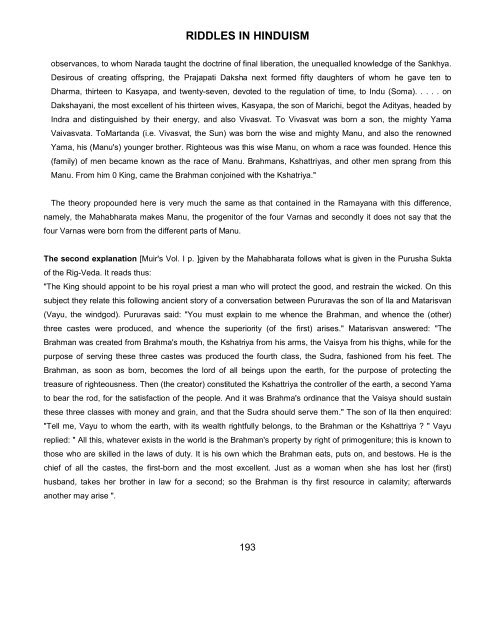Create successful ePaper yourself
Turn your PDF publications into a flip-book with our unique Google optimized e-Paper software.
RIDDLES IN HINDUISM<br />
observances, to whom Narada taught the doctr<strong>in</strong>e of f<strong>in</strong>al liberation, the unequalled knowledge of the Sankhya.<br />
Desirous of creat<strong>in</strong>g offspr<strong>in</strong>g, the Prajapati Daksha next formed fifty daughters of whom he gave ten to<br />
Dharma, thirteen to Kasyapa, and twenty-seven, devoted to the regulation of time, to Indu (Soma). . . . . on<br />
Dakshayani, the most excellent of his thirteen wives, Kasyapa, the son of Marichi, begot the Adityas, headed by<br />
Indra and dist<strong>in</strong>guished by their energy, and also Vivasvat. To Vivasvat was born a son, the mighty Yama<br />
Vaivasvata. ToMartanda (i.e. Vivasvat, the Sun) was born the wise and mighty Manu, and also the renowned<br />
Yama, his (Manu's) younger brother. Righteous was this wise Manu, on whom a race was founded. Hence this<br />
(family) of men became known as the race of Manu. Brahmans, Kshattriyas, and other men sprang from this<br />
Manu. From him 0 K<strong>in</strong>g, came the Brahman conjo<strong>in</strong>ed with the Kshatriya."<br />
The theory propounded here is very much the same as that conta<strong>in</strong>ed <strong>in</strong> the Ramayana with this difference,<br />
namely, the Mahabharata makes Manu, the progenitor of the four Varnas and secondly it does not say that the<br />
four Varnas were born from the different parts of Manu.<br />
The second explanation [Muir's Vol. I p. ]given by the Mahabharata follows what is given <strong>in</strong> the Purusha Sukta<br />
of the Rig-Veda. It reads thus:<br />
"The K<strong>in</strong>g should appo<strong>in</strong>t to be his royal priest a man who will protect the good, and restra<strong>in</strong> the wicked. On this<br />
subject they relate this follow<strong>in</strong>g ancient story of a conversation between Pururavas the son of lla and Matarisvan<br />
(Vayu, the w<strong>in</strong>dgod). Pururavas said: "You must expla<strong>in</strong> to me whence the Brahman, and whence the (other)<br />
three castes were produced, and whence the superiority (of the first) arises." Matarisvan answered: "The<br />
Brahman was created from Brahma's mouth, the Kshatriya from his arms, the Vaisya from his thighs, while for the<br />
purpose of serv<strong>in</strong>g these three castes was produced the fourth class, the Sudra, fashioned from his feet. The<br />
Brahman, as soon as born, becomes the lord of all be<strong>in</strong>gs upon the earth, for the purpose of protect<strong>in</strong>g the<br />
treasure of righteousness. Then (the creator) constituted the Kshattriya the controller of the earth, a second Yama<br />
to bear the rod, for the satisfaction of the people. And it was Brahma's ord<strong>in</strong>ance that the Vaisya should susta<strong>in</strong><br />
these three classes with money and gra<strong>in</strong>, and that the Sudra should serve them." The son of lla then enquired:<br />
"Tell me, Vayu to whom the earth, with its wealth rightfully belongs, to the Brahman or the Kshattriya ? " Vayu<br />
replied: " All this, whatever exists <strong>in</strong> the world is the Brahman's property by right of primogeniture; this is known to<br />
those who are skilled <strong>in</strong> the laws of duty. It is his own which the Brahman eats, puts on, and bestows. He is the<br />
chief of all the castes, the first-born and the most excellent. Just as a woman when she has lost her (first)<br />
husband, takes her brother <strong>in</strong> law for a second; so the Brahman is thy first resource <strong>in</strong> calamity; afterwards<br />
another may arise ".<br />
193


















